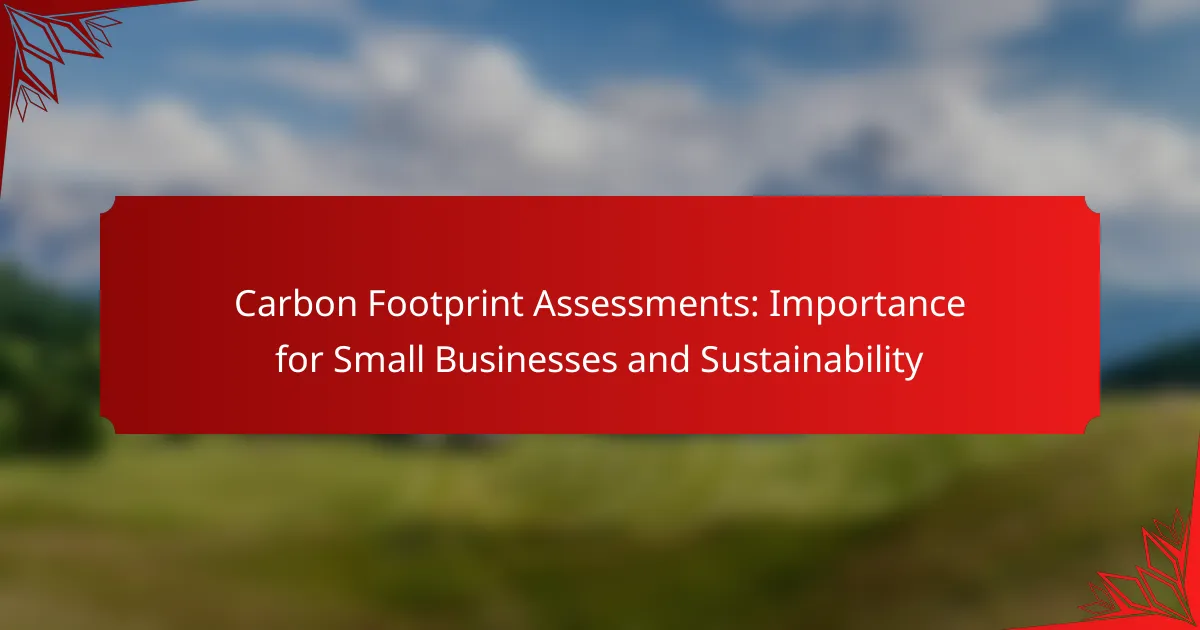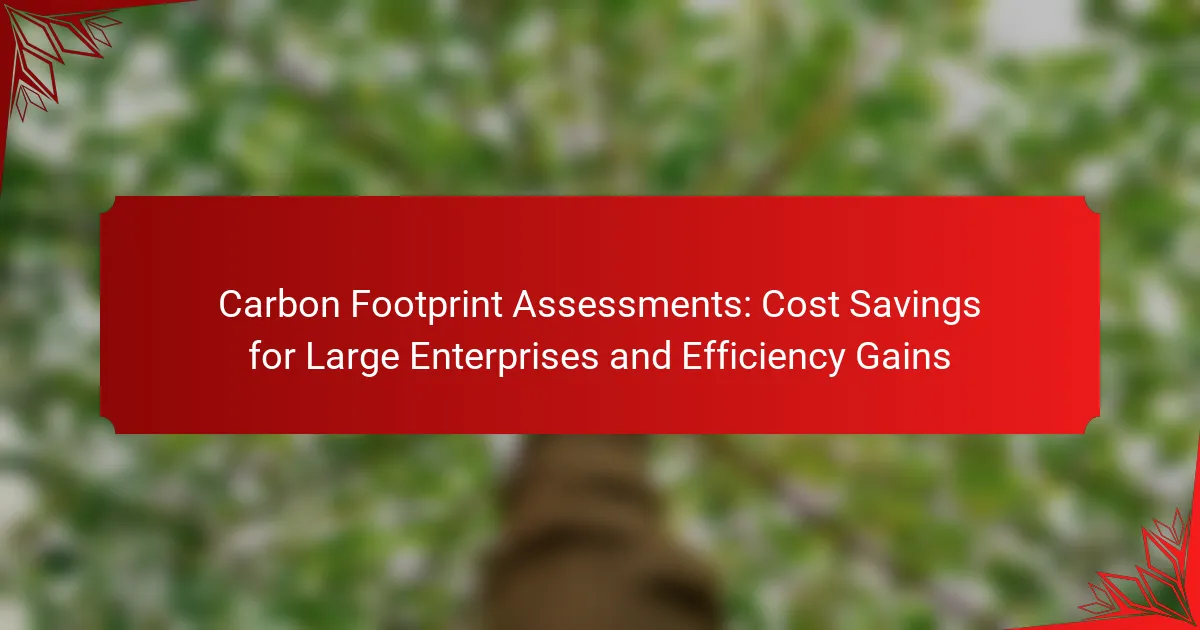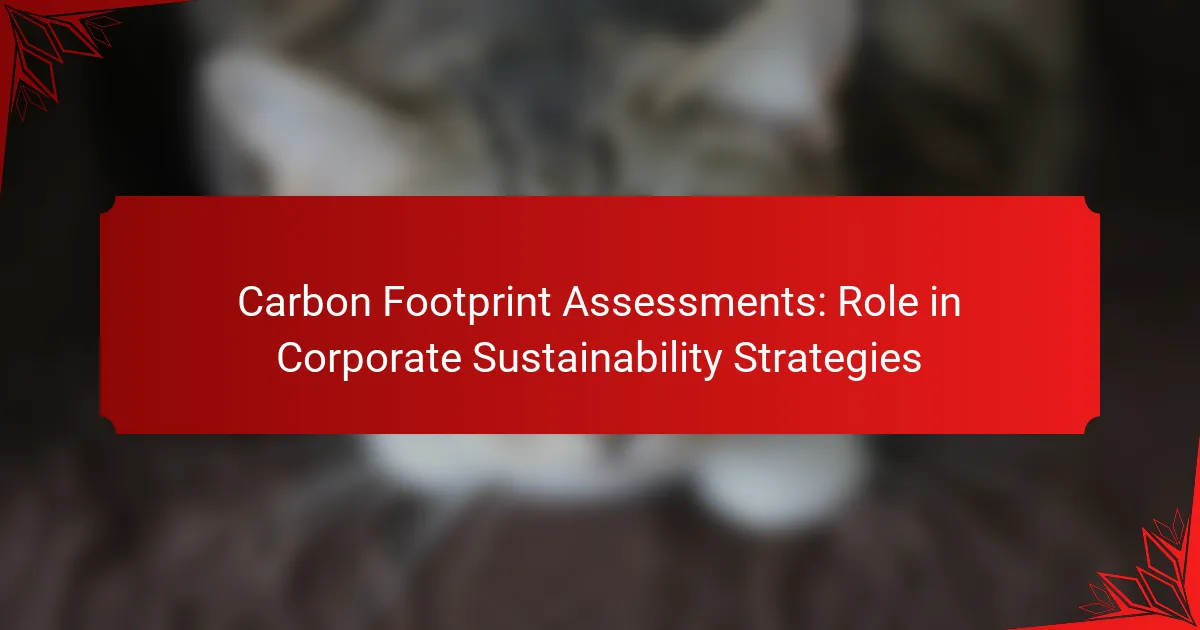Carbon footprint assessments are essential tools for businesses aiming to improve sustainability and operational efficiency. By identifying key areas for emissions reduction, these assessments not only help companies cut costs and enhance their reputation but also ensure compliance with environmental regulations. Industries with high emissions, such as manufacturing, transportation, and retail, can particularly benefit from implementing these assessments to foster better sustainability practices.

How do carbon footprint assessments benefit businesses in the United States?
Carbon footprint assessments provide significant advantages for businesses in the United States by identifying areas for improvement in sustainability and operational efficiency. These assessments help companies reduce costs, enhance their reputation, and ensure compliance with environmental regulations.
Cost savings through efficiency
Conducting carbon footprint assessments allows businesses to pinpoint inefficiencies in their operations, leading to potential cost savings. By optimizing energy use and reducing waste, companies can lower their utility bills and operational expenses. For instance, a manufacturing firm might find that upgrading machinery could reduce energy consumption by 20-30%.
Additionally, implementing energy-efficient practices can qualify businesses for tax incentives or rebates, further enhancing financial benefits. Regular assessments can help track progress and identify new opportunities for savings over time.
Enhanced brand reputation
Businesses that actively engage in carbon footprint assessments often see an improvement in their brand reputation. Consumers are increasingly favoring companies that demonstrate environmental responsibility, which can lead to increased customer loyalty and sales. For example, a retail company that showcases its commitment to sustainability through transparent reporting may attract eco-conscious shoppers.
Moreover, participating in carbon reduction initiatives can enhance a company’s public image and differentiate it from competitors. Companies can leverage their sustainability efforts in marketing campaigns, fostering a positive perception among stakeholders.
Compliance with regulations
In the United States, businesses are subject to various environmental regulations that require monitoring and reporting of carbon emissions. Carbon footprint assessments help ensure compliance with these regulations, reducing the risk of fines or legal issues. For instance, companies in certain industries may need to adhere to the Environmental Protection Agency’s (EPA) greenhouse gas reporting requirements.
By staying ahead of regulatory changes and demonstrating proactive measures to reduce emissions, businesses can not only avoid penalties but also position themselves as leaders in sustainability within their industry. Regular assessments can assist in maintaining compliance and preparing for future regulations effectively.
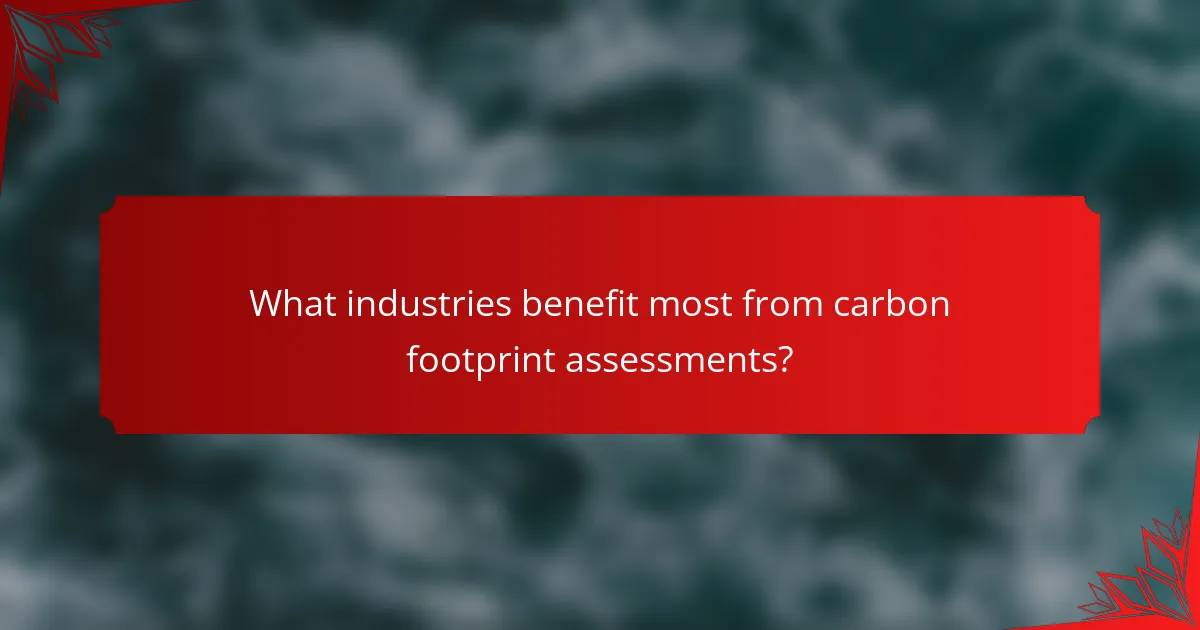
What industries benefit most from carbon footprint assessments?
Carbon footprint assessments are particularly beneficial for industries with significant emissions, such as manufacturing, transportation, and retail. These sectors can leverage assessments to identify reduction opportunities, enhance sustainability practices, and comply with regulations.
Manufacturing sector
The manufacturing sector is one of the largest contributors to carbon emissions, making carbon footprint assessments crucial for identifying inefficiencies. By measuring emissions from production processes, companies can target areas for improvement, such as energy consumption and waste management.
Implementing energy-efficient technologies and optimizing supply chains can lead to substantial reductions in carbon output. For example, manufacturers that switch to renewable energy sources may reduce their emissions by 20-30% over time.
Transportation and logistics
Transportation and logistics industries are heavily reliant on fossil fuels, making carbon footprint assessments essential for tracking emissions from vehicles and shipping methods. By evaluating fuel consumption and route efficiency, companies can uncover opportunities for reducing their carbon footprint.
Strategies such as adopting electric vehicles or optimizing delivery routes can significantly lower emissions. Companies that implement these changes often see reductions of 10-15% in their overall carbon output.
Retail industry
The retail industry can benefit from carbon footprint assessments by evaluating emissions associated with product sourcing, transportation, and store operations. Understanding these emissions helps retailers make informed decisions about sustainable practices and product offerings.
For instance, retailers can choose to source products from local suppliers to reduce transportation emissions or implement energy-efficient lighting in stores. These changes can lead to a reduction of 5-10% in overall carbon emissions.

What are the best practices for conducting carbon footprint assessments?
Best practices for conducting carbon footprint assessments involve utilizing standardized methodologies, engaging stakeholders, and regularly updating assessments. These practices ensure accuracy, relevance, and comprehensive understanding of an organization’s carbon emissions.
Utilizing standardized methodologies
Standardized methodologies provide a consistent framework for measuring carbon footprints across different industries. Common standards include the Greenhouse Gas Protocol and ISO 14064, which outline specific guidelines for quantifying emissions.
By adhering to these established protocols, organizations can ensure comparability of their results with industry benchmarks. This is crucial for identifying areas for improvement and demonstrating accountability to stakeholders.
Engaging stakeholders
Engaging stakeholders is vital for a successful carbon footprint assessment. Involving employees, suppliers, and customers can provide valuable insights into emissions sources and help foster a culture of sustainability within the organization.
Regular communication with stakeholders also enhances transparency and encourages collaboration on sustainability initiatives. For example, conducting workshops or surveys can help gather input and increase buy-in for carbon reduction strategies.
Regularly updating assessments
Regularly updating carbon footprint assessments is essential to reflect changes in operations, technology, and regulations. Annual reviews are recommended to capture new data and adjust for any significant shifts in business practices.
Staying current with assessments allows organizations to track progress towards emissions reduction goals and adapt strategies as needed. This proactive approach can also help in complying with evolving environmental regulations and standards.
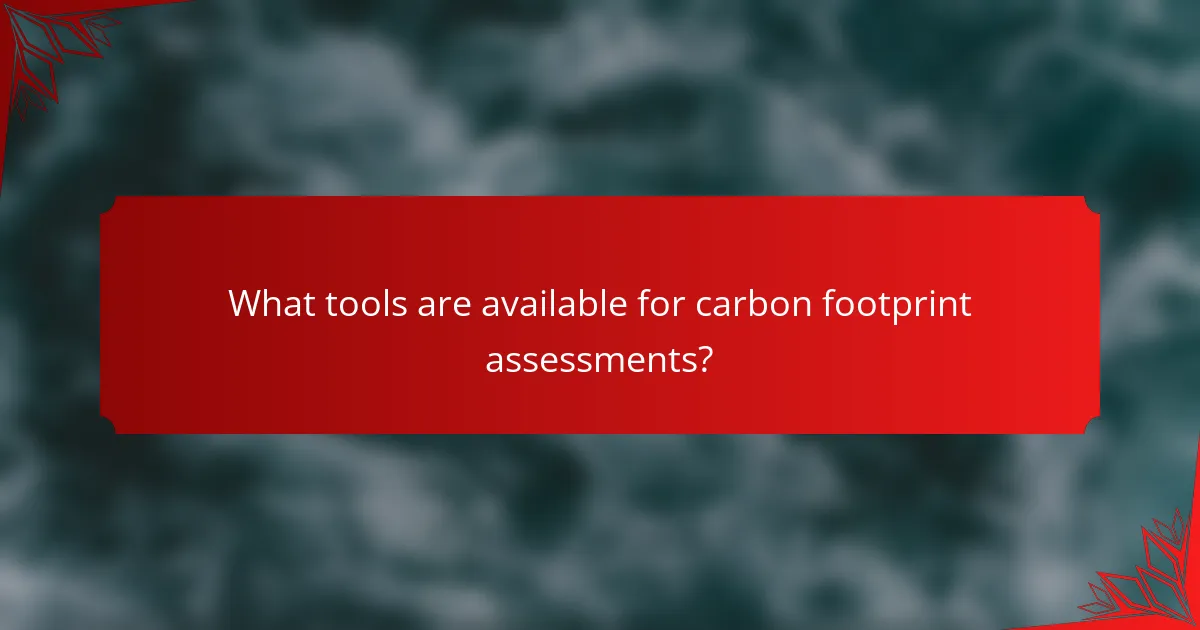
What tools are available for carbon footprint assessments?
Several tools are available for carbon footprint assessments, each tailored to different industries and needs. These tools help organizations measure, manage, and reduce their greenhouse gas emissions effectively.
Carbon Trust Footprint Calculator
The Carbon Trust Footprint Calculator is an online tool designed for businesses to estimate their carbon emissions. It provides a user-friendly interface where organizations can input data related to energy consumption, travel, and waste management.
This calculator can help identify key areas for improvement, allowing companies to develop targeted strategies for reducing their carbon footprint. It’s particularly useful for small to medium-sized enterprises looking to enhance their sustainability efforts without extensive resources.
Greenhouse Gas Protocol tools
The Greenhouse Gas Protocol offers a suite of tools aimed at standardizing carbon accounting across various sectors. These tools include the Corporate Standard, Project Quantification Standard, and various calculation tools that help organizations measure emissions from different activities.
These resources are beneficial for companies seeking to align with international standards and enhance transparency in their reporting. Organizations can use these tools to benchmark their performance against industry peers and identify best practices for emissions reduction.
SIMAP for universities
SIMAP is a specialized tool for higher education institutions to assess and manage their carbon footprints. It provides a comprehensive framework for universities to track emissions from various sources, including energy use, transportation, and waste.
This platform not only helps universities measure their carbon impact but also supports them in setting reduction targets and implementing sustainability initiatives. By using SIMAP, institutions can engage students and staff in their sustainability efforts, fostering a culture of environmental responsibility.

How can companies choose the right carbon footprint assessment method?
Companies can select the appropriate carbon footprint assessment method by aligning it with their specific goals, industry standards, and available resources. Understanding these factors helps ensure that the chosen method effectively measures and reduces their carbon emissions.
Evaluating organizational goals
Identifying organizational goals is crucial in selecting a carbon footprint assessment method. Companies should consider whether they aim to comply with regulations, enhance sustainability practices, or improve public image. For instance, a business focused on regulatory compliance may prioritize methods that align with local or international standards.
Additionally, companies should define their long-term sustainability objectives. If a goal is to achieve net-zero emissions by a certain year, a more comprehensive assessment method may be necessary to track progress accurately.
Considering industry standards
Industry standards play a significant role in determining the right carbon footprint assessment method. Different sectors may have specific guidelines or frameworks, such as the Greenhouse Gas Protocol or ISO 14064. Familiarizing oneself with these standards can help ensure that the assessment is credible and recognized.
Moreover, companies should look at best practices within their industry. Engaging with industry groups or networks can provide insights into effective assessment methods that peers are successfully using.
Assessing available resources
Assessing available resources is essential when choosing a carbon footprint assessment method. Companies should evaluate their budget, personnel, and technological capabilities. For example, a small business may opt for a simpler, less costly method, while larger organizations might invest in more sophisticated tools and software.
Additionally, consider the time required for the assessment. Some methods may demand extensive data collection and analysis, which could strain limited resources. Prioritizing methods that fit within the company’s operational capacity can lead to more effective outcomes.
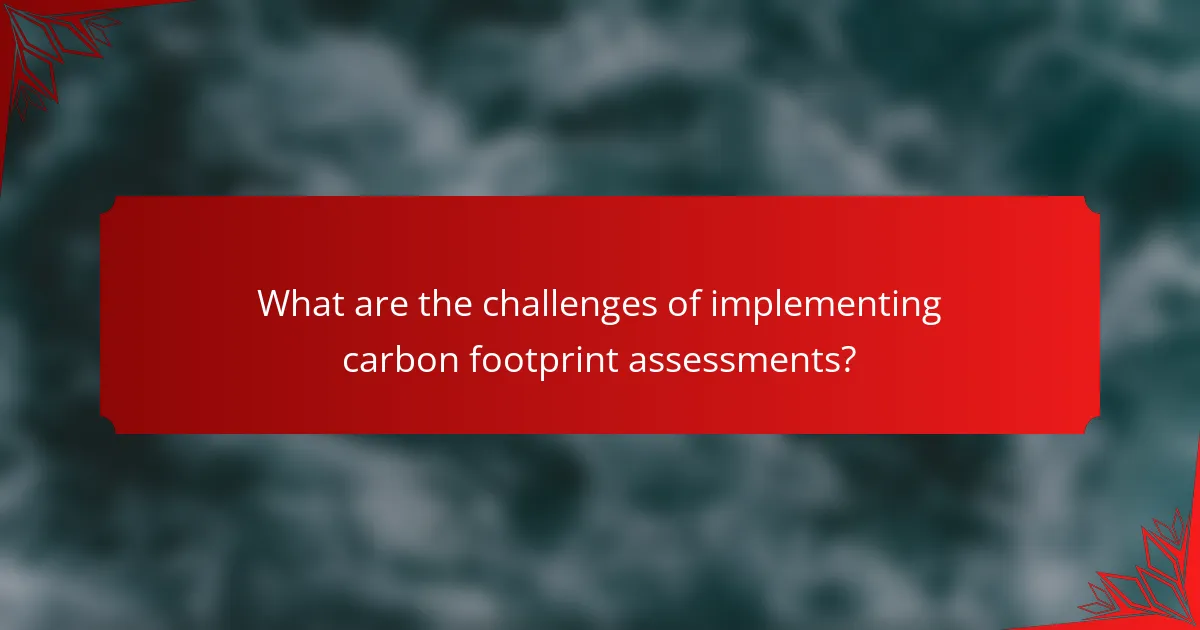
What are the challenges of implementing carbon footprint assessments?
Implementing carbon footprint assessments presents several challenges, including data collection difficulties, varying methodologies, and the need for industry-specific adaptations. Organizations often struggle with the accuracy and completeness of data, which can hinder effective assessments.
Data Collection Issues
One of the primary challenges in carbon footprint assessments is gathering accurate data. Many companies lack comprehensive records of their energy use, waste production, and supply chain emissions. This can lead to incomplete assessments and unreliable results.
To mitigate data collection issues, organizations should establish clear protocols for tracking emissions sources and invest in training staff on data management. Utilizing software tools can streamline this process and enhance data accuracy.
Methodological Variability
Different methodologies for calculating carbon footprints can lead to inconsistencies in results. Organizations may choose from various standards, such as the Greenhouse Gas Protocol or ISO 14064, each with its own approach and requirements.
To address methodological variability, companies should select a standard that aligns with their industry and regulatory environment. Consistency in methodology is crucial for benchmarking and reporting purposes.
Industry-Specific Adaptations
Industries have unique characteristics that affect their carbon footprint assessments. For example, manufacturing sectors may focus on direct emissions from production processes, while service industries might prioritize energy consumption in office spaces.
Organizations should tailor their assessments to reflect these industry-specific factors. Engaging with industry groups or consultants can provide valuable insights into best practices and relevant metrics for accurate assessments.

